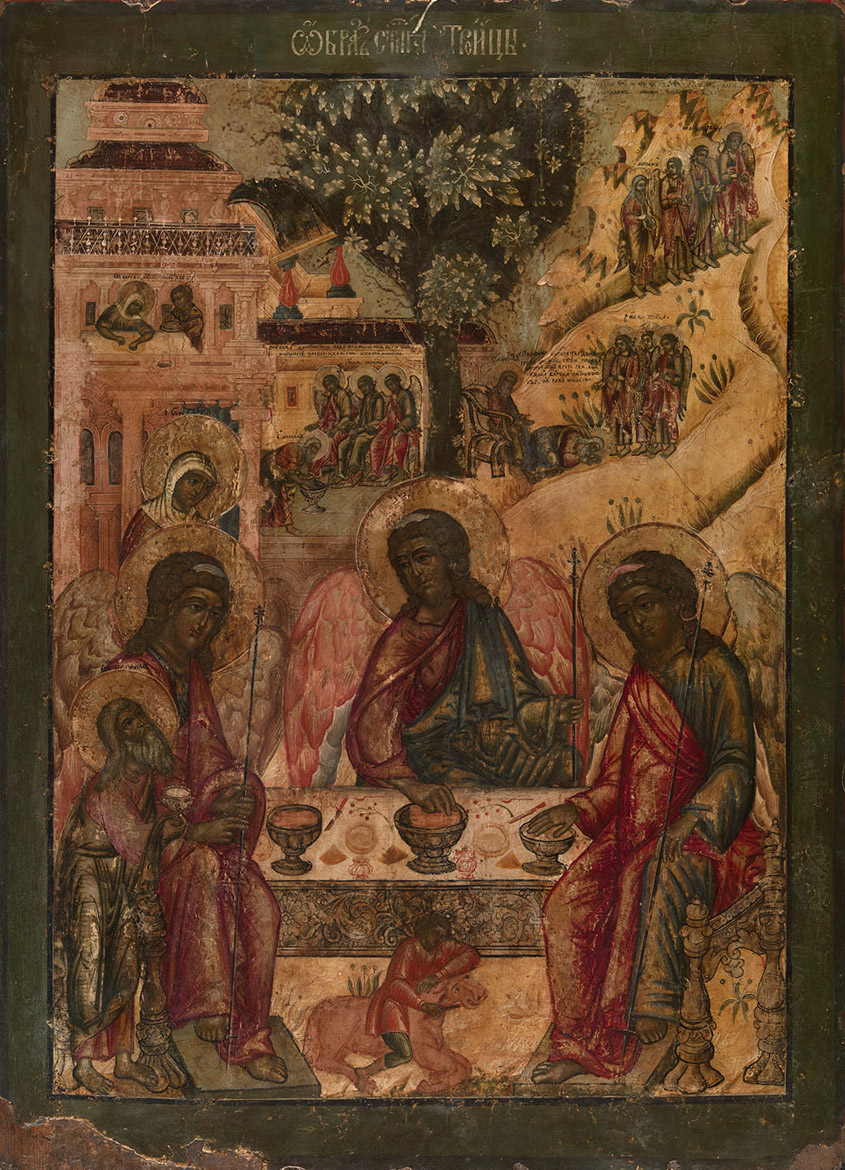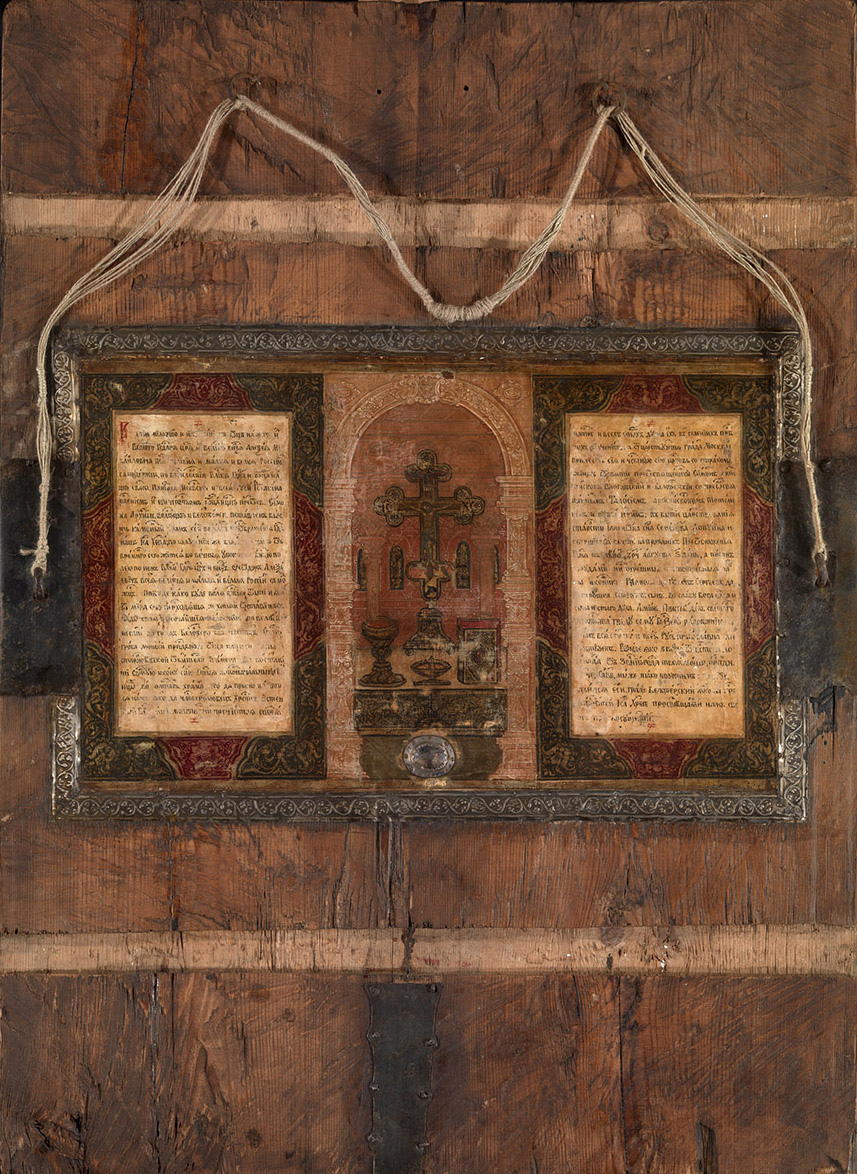MacDougall Auctions 2-3 December 2009
2 December 2009

45. A LARGE IMPORTANT ICON OF THE OLD TESTAMENT TRINITY WITH A FRAGMENT OF THE RELICS OF HOLY SAVVA STOROZHEVSKY
YERMOLAI AND YAKOV SERGEEV, PETR SEMYONOV, 1682, INSCRIBED INSERT (VRESOK) ON THE REVERSE
108 by 95 cm.
230,000-250,000 pounds
Literature: Exhibition catalogue , Icona volto del mister, Milan, 1991, pp. 108–109, pl 25.
The icon originates from the Veneration Tier of the iconostasis from the Transfiguration Cathedral in Belozersk. It was commissioned in 1682 by Tsar Fyodor Alexeevich from three Vologda artists, the brothers Yermolai and Yakov Sergeev and Peterkin (Petrushka) Semyonov, and delivered, together with the inserted fragment of the relics of St Sabbas of Storozhev, to the newly-consecrated Cathedral of Transfiguration in Belozersk, built of stone in 1668-1670. On the reverse of the icon, there is a special inserted panel, encased in a silver-embossed frame, bearing the detailed depiction of a chancel with the Holy Altar and the most important liturgical artefacts upon it: a silver cross with the painted image of the Crucifixion, the chalice, the paten and the Gospel in a precious cover. Under the altar slab, according to the Christian tradition, there are relics of the Venerable Sabbas of Storozhev, as explained in the accompanying inscription. The image is flanked by two white panels in richly decorated frames, testifying to the commission of the icon:
“By the great mercy and careful support of our father the Great Lord Tsar and Great Prince Alexei Mikhailovich, the autocrat of all Great, Small, and White Russia, and by the blessing of the Great Lord Joachim, the Most Holy Patriarch of Moscow and All Russia, and by the zeal and care of our father the Right Reverend Simon, the Archbishop of Vologda and Belozersk, this stone church has been erected in the name of the Transfiguration of Our Lord Jesus Christ. When, however, our bene factor was snatched by God’s will away from this transient life into eternal rest, after him the Great Lord Tsar and Prince Fyodor Alexeevich, the autocrat of all Great, Small, and White Russia, [took over]. Before it is God’s will for him also to leave this transient world, he did not want to abandon us, his children, without his most high mercy and commanded parts of the relics from the holy shrine of our most venerable father Savva, the abbot of the monastery of Storozhev, to be carried to the town of Beloozero and for this holy icon of the holy life-giving Trinity to be installed in the altar of this church in order that we could perpetually pray so that the lover of mankind, Christ our true God, through the prayers of His most Pure Mother and all the saints, will establish their souls in the dwellings of the righteous. The Right Reverend Simon, the archbishop of Volog da and Belozersk, brought these [holy relics] from the capital city of Moscow, and consecrated this church with the fear of God, together with the Right Reverend Talosius, archbishop of Totma and Veliky Ustyug, while Hilarion, son of Semyon Lopikhin, was ruling as the elder. And this took place on the feast day of Our Lord’s Transfi guration, in the year of Our Lord 7190 (i.e. 1682), on 6 August, and [this icon] was painted through the labours of the most sinful and indecent work of the icon painters Yermolai and Yakov Sergeev and Peterkin (Petrushka) son of Semyon. To the glory of God the Father and the Son and the Holy Spirit. Amen. A day of radiant celebration has come to this town of Belozero, and with it all the country and the state of Orthodox Russia is rejoicing. Your relics, oh most venerable father, have shone forth in Zvenigorod from the east to the west like a star, and so will we also cry aloud: thou hast been transfigured, oh town of Belozersk, as if upon the Mount of Tabor, enlightening us about Jesus Christ, the light everlasting”.
The extended iconography of the Hospitality of Abraham and Sarah (the Old Testament Trinity) was established in Russian art in the middle of the 17th century. Apart from the depiction of the feast of the Three Angels, the servant killing the fatted calf and the Forbearers (who are, unusually, asymmetrically placed behind the back of the left angel) the icon contains the illustrations of the acts that accompanied the divine visit: the meeting of the three travellers by Abraham, the washing of their feet by the door of his house, the making of bread by Sarah, and Abraham receiving the Angels blessing and bidding them farewell.

Notes on symbols:
* Indicates 5% Import Duty Charge applies.
Ω Indicates 20% Import Duty Charge applies.
§ Indicates Artist's Resale Right applies.
† Indicates Standard VAT scheme applies, and the rate of 20% VAT will be charged on both hammer price and premium.